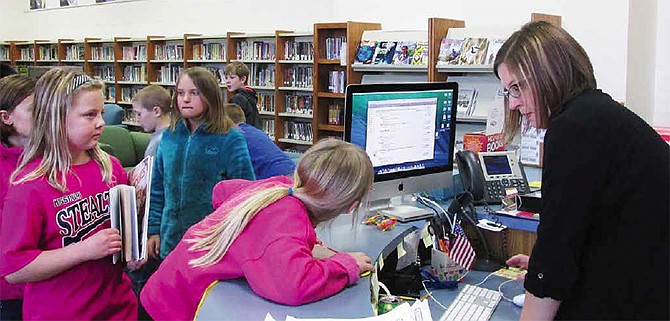MOKANE, Mo. - Since October, South Callaway elementary and middle school students have used individual reading scores to find the best fit for them when checking out books at the library.
The Lexile Leveling program helps media specialist Megan Nieland identify book readability and helps students find books in their reading level. To help students become more independent in the library, Nieland started adding color-coded stickers to the books to help students determine if it's the right fit for them.
Teachers have students take a Scholastic Reading Inventory, which has varying levels for the different reading capabilities. They can administer the inventory at their discretion- some have selected to administer it quarterly, while others do it several times over the course of the year to track progress.
"There is controversy with leveling libraries," Nieland said. "It limits the students' freedom in choosing, but I allow students to check out two - one book from their level and one of their choice, no matter its lexile level."
While Nieland has not received any complaints for introducing the lexile scale to the South Callaway elementary and middle school, research has indicated that students with a limited choice don't feel encouraged to read and therefore, don't.
"I try not to limit (the level) because I want them to be motivated to get help if they need it, especially if it's something that interests them," Nieland said.
While not all 10,000 books at the middle school library have been marked at their level, students can bring the book to Nieland who can check the book's lexile level online. The program inspects the text and gives the book a lexile level for its readability.
Nieland expects to have the books leveled by the end of the year.
Another program Nieland has been wading into is developing a Maker Space in the middle school's library media center.
The program creates a place where students can go to work on projects and activities that coincide with the science, technology, engineering, arts and mathematics movement, Nieland said. In the designated space, students can get hands-on experience with tools, software and art supplies that aren't available to them in their regular classroom.
"It gives them real-life experience and it gives them a place to fail," Nieland said. "In the real world, you have to try and fail and try again. Kids need to understand that it's okay to not get something right the first time, but that it's important to resolve the issue and learn how to make it work. I think kids are afraid of trying something new and failing."
While Nieland hasn't been moving full steam ahead, she has kept an eye out for grants and asked teachers around the district to donate supplies they no longer use in their classroom. So far, she has received a lot of Legos and other building materials.
Nieland hopes the Maker Space will become a reality in the next year or so and provide student access to coding programs and a 3D printer that she said, "are out in the real world."
The designated space would also be available to teachers and their classes so that the material could be implemented into the curriculum for different class projects.

